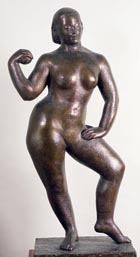Research Method
The research method was developed during a two-year development phase (2005-2006) that was supported by the Henry Moore Foundation and included a pilot study. From an early stage it was clear that visiting every archive in Britain and Ireland was impractical. Research carried out during the project's pilot study indicated that between 1851-1951 around 80% of sculptural activity took place in seventeen cities. The research programme is therefore focused on these places, which have been grouped into six research centres with a Research Assistants appointed to each one:
- Scotland (Aberdeen, Edinburgh, Glasgow)
- North of England (Leeds, Liverpool, Manchester and Newcastle)
- Ireland (Dublin and Belfast)
- Wales (Cardiff, Conwy, Swansea, Bristol and London)
- Central England (Birmingham, Nottingham, Stoke-on-Trent)
- London (treated as a region because of the volume of materials)
Content selection and data entry
In each of the cities listed above, the Research Assistants are gathering specified categories of data from selected groups of sources to create the equivalent to a curriculum vitae for sculptors and related businesses. The Research Assistants are also capturing details of relationships between people, objects, organisations, events and places (plus associated references).
By pooling all of the information gathered in each city and region in a central database the 'mapping' of profession and practice across Britain and Ireland is being achieved. A fully relational database has been specially designed for the project by the Humanities Advanced Technology and Information Institute (HATII) at the University of Glasgow. When the database is launched in 2010, users will be able to explore and analyze the project data via a wide range of queries, revealing numerous underlying connections and investigate many topics relating to the practice and profession of sculpture.
Research Parameters
An important part of the Mapping Sculpture 1851-1951 method is the parameters defining where the project begins and ends, and who is included and who is not. The principal criteria are as follows:
- The research is focused on those who were actively practicing sculpture or in business between 1851 and 1951. This excludes those who had retired from making and exhibiting sculpture by the early 1850s or, at the other end of the period, had not yet established a professional career. So, for example, sculptors who were still at art school or had only just completed their studies will not be recorded.
- The project uses activity not place of birth as the criterion for inclusion, and therefore any foreign sculptors who worked in Britain and Ireland during this century are documented.
- Where a sculptor's career extended beyond 1951, only the portion within the project timeframe is being documented in the database. However, some references to additional published and documentary materials post-1951 will be provided as a starting point for further research.
- As the research is only gathering data post-1851, any portion of a sculptor's career from before this date will not be recorded. However, the database will include references to A Dictionary of British Sculptors 1660-1851, by Ingrid Roscoe, Greg Sullivan, and Emma Hardy (Yale University Press, 2009), which contains full biographies for sculptors born up to 1851.

QUICKLINKS

